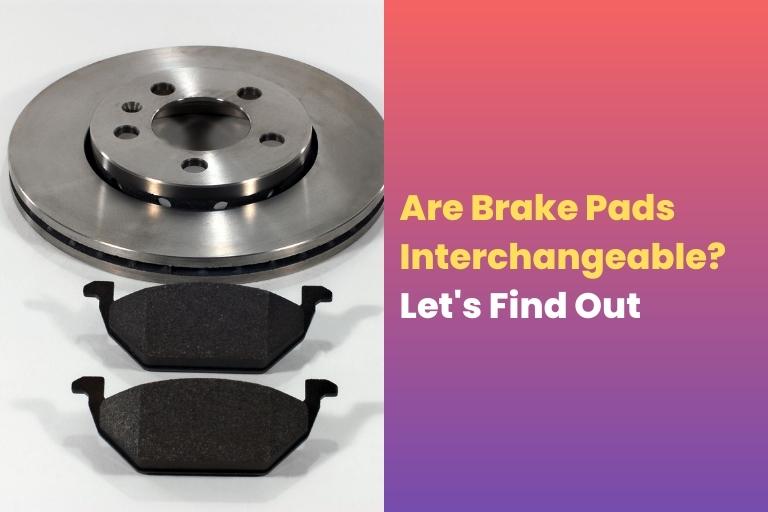If you own a car or are interested in how vehicles function, you’ve thought about brake pads. These little but important components function in a vehicle’s braking system, allowing you to slow down and stop safely. But have you ever wondered if brake pads can be swapped? Can you replace them with any other brake pads on the market?
In this article, we’ll delve into the world of brake pads, exploring what they are, why they’re important, and whether or not they can be interchanged. So buckle up, and let’s dive in!
Contents
- 1 Are Brake Pads Interchangeable?
- 2 Are Brake Pads And Rotors The Same Front And Rear?
- 3 How Do I Know What Brake Pads And Rotors Fit My Car?
- 4 How to determine what brake pads and rotors fit your car
- 5 Differences between the front and rear brake pads and rotors
- 6 Aftermarket vs. OEM brake parts
- 7 Types of Brake Pads I need
- 8 Types of Rotors
- 9 Which Combination Of Pads And Rotors Works Best?
- 10 Can I Swap Brake Parts with Other Cars?
- 11 Can I Change Brake Pads And Rotors Myself?
- 12 Conclusion
Are Brake Pads Interchangeable?
Brake pads are not interchangeable between different vehicles. They are designed to fit specific makes and models of cars and trucks. It is important to use the correct brake pads for your vehicle to ensure proper braking performance and safety.
Are Brake Pads And Rotors The Same Front And Rear?
No, brake pads and rotors are not the same for a vehicle’s front and back wheels. The friction substance that presses against the brake rotors to slow or stop the vehicle is known as brake pads. To meet the varied weight distribution while braking, front, and rear brake pads may differ in size, thickness, and composition.
Front brake pads are typically bigger and thicker to accommodate higher braking power.
Brake rotors, or brake discs, are the revolving metal discs onto which the brake pads are clamped. Front and rear rotors may differ in size, shape, and cooling capabilities. Front rotors are frequently bigger and vented to better disperse heat created during braking.
Using the proper brake pads and rotors for each wheel is critical for safe and effective braking performance. To ensure you have the correct brake pads and rotors for your vehicle’s front and back wheels, follow the manufacturer’s instructions or speak with a skilled mechanic. Brake pad and rotor maintenance and replacement are critical for your vehicle’s and its occupants’ safety.
How Do I Know What Brake Pads And Rotors Fit My Car?
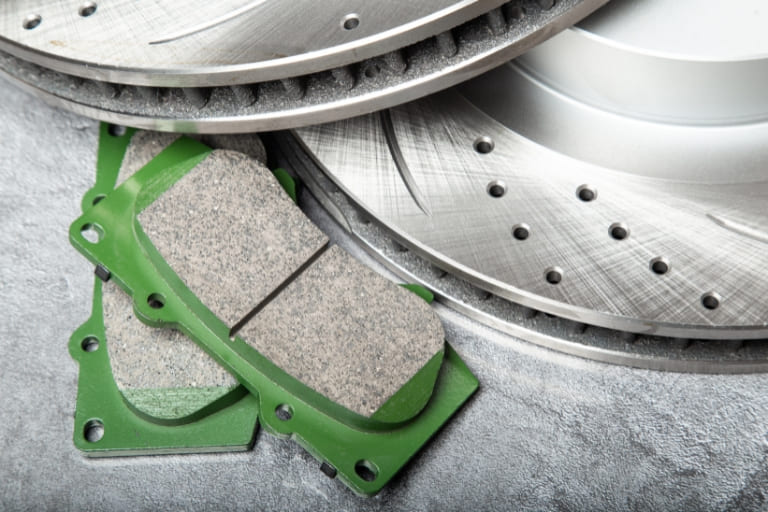
It is of the utmost importance to use the proper brake pads and rotors to guarantee safe and effective braking performance, maximum vehicle performance, longevity, warranty compliance, and cost-effectiveness. Brake pads and rotors that are mismatched or incorrect can reduce braking performance, increase wear and maintenance expenses, void warranties, and even pose safety issues.
To ensure that the right brake pads and rotors are utilized for your vehicle’s front and rear wheels, it’s critical to follow manufacturer recommendations and speak with competent specialists.
How to determine what brake pads and rotors fit your car
Selecting the right brake pads and rotors for your vehicle requires many stages:
- Review your vehicle’s owner’s handbook, which frequently includes information about appropriate brake pads and rotor specifications.
- Second, get counsel from a reputable technician or parts supplier who can assist you in determining the proper brake pads and rotors depending on your vehicle’s make, model, year, and any special trim or package choices.
- Third, look into reputed brake pad and rotor brands and cross-check component numbers to confirm compatibility. Take into account your driving patterns as well as your preferences for braking performance, durability, and noise levels.
- Finally, if you are doubtful, get expert guidance to ensure proper fitting and performance for your unique vehicle.
Differences between the front and rear brake pads and rotors
To satisfy the particular demands of each wheel, front and rear brake pads, and rotors may differ in size, thickness, and design. Because of the vehicle’s weight distribution and braking power, front brake pads and rotors often face more heat and wear. To meet the needs of the rear wheel, rear brake pads and rotors may be smaller and have distinct properties.
Aftermarket vs. OEM brake parts
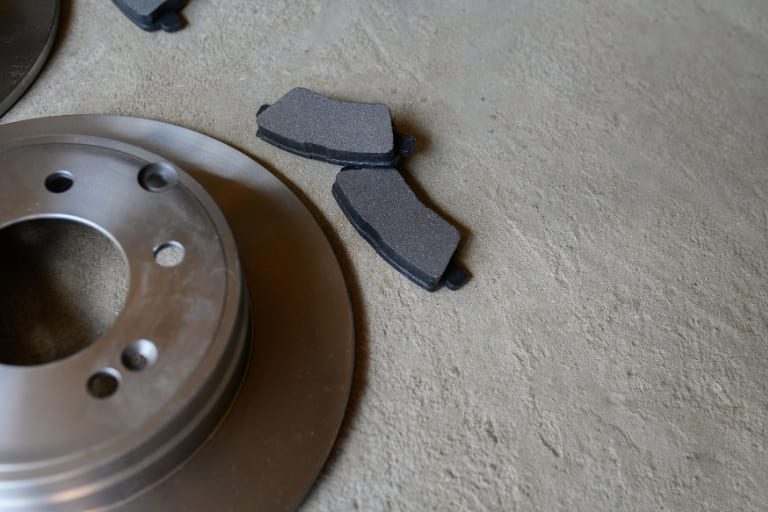
Third-party firms manufacture aftermarket brake components, whereas the vehicle’s original equipment manufacturer manufactures OEM brake parts.
OEM components are manufactured to stringent manufacturer requirements, assuring excellent quality and dependability, but aftermarket parts may vary in quality and fitting. OEM components often have a manufacturer’s guarantee and are supported by the vehicle manufacturer.
In contrast, aftermarket parts may provide more alternatives but may lack the same degree of quality control and warranty support. Consider your needs, budget, and preferences when picking between aftermarket and OEM brake parts.
Types of Brake Pads I need
Several criteria, including your driving patterns, vehicle type, and personal preferences, determine the optimum brake pad for your automobile. Let’s go more into the three types of brake pads you mentioned:
Organic brake pads
Organic brake pads are constructed from natural materials such as rubber, glass, and resins. They are often inexpensive and have adequate stopping force while making little noise and dust. Organic brake pads are often appropriate for light to moderate driving circumstances, such as commuting and city driving.
Ceramic brake pads
Ceramic brake pads are created from ceramic materials mixed with additional components such as copper or ceramic fibers. They are well-known for their low noise and dust levels and their excellent heat dissipation capabilities. Ceramic brake pads are normally more costly than organic pads, but they perform and last longer. They are appropriate for various driving circumstances, including high-performance and heavy-duty applications.
Semi-metallic brake pads
Semi-metallic brake pads are constructed of a mix of metallic fibers, such as steel and organic components. They are suited for heavy-duty applications and high-performance driving because they have exceptional stopping power and durability. They may, however, create more noise and dust than organic or ceramic brake pads.
Ceramic brake pads are generally considered the best option for most cars because of their overall performance, low noise and dust levels, and longevity. On the other hand, the finest brake pad for your automobile is determined by your unique driving demands, vehicle type, and budget. When selecting the correct brake pads for your automobile, always examine your vehicle’s owner’s handbook, get assistance from a reliable technician or parts supplier, and consider your driving patterns and preferences.
Types of Rotors
Many criteria, including your driving behavior, vehicle type, and personal preferences, determine your automobile’s ideal rotor. Let’s look more closely at the four-rotor kinds you mentioned:
Plain rotors
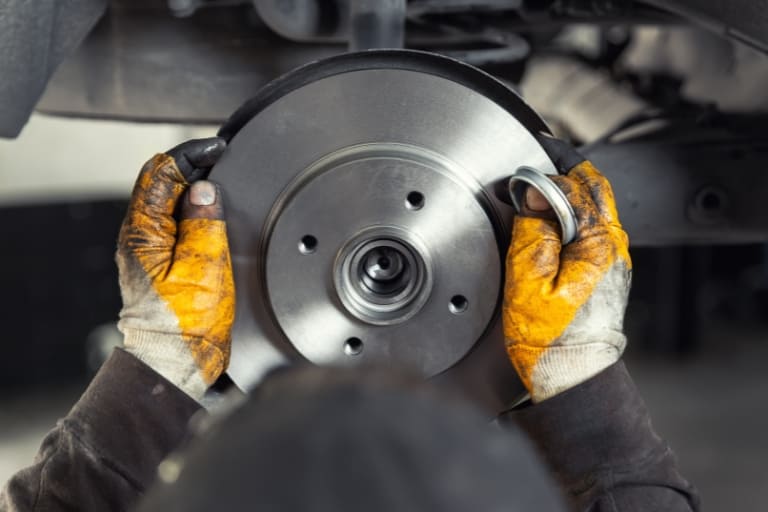
Plain rotors have a smooth, flat surface devoid of slots or holes. They are the most basic and least expensive form of the rotor. Plain rotors provide steady and dependable braking performance, making them appropriate for daily driving and commuting.
Slotted rotors
Slotted rotors feature grooves cut onto their surface to help vent gases and heat that may accumulate during braking. Slotted rotors can increase braking performance while lowering the danger of brake fade, making them suited for more aggressive driving or heavy-duty applications. They may also aid in removing brake dirt and water from the rotor surface, improving braking performance in wet situations.
Drilled rotors
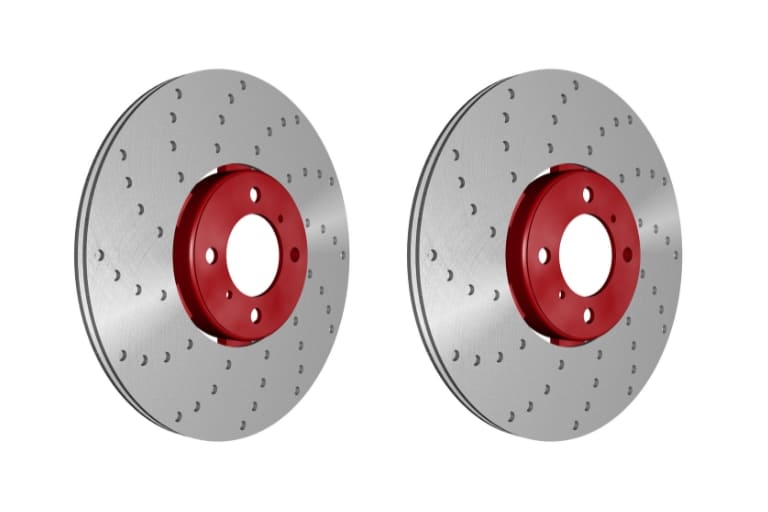
These rotors have holes drilled into their surfaces, aiding in heat dissipation and weight reduction. Drilled rotors can improve heat dissipation and lower the likelihood of brake fade, making them appropriate for high-performance driving or heavy-duty applications. However, they may be more prone to cracking or warping in harsh temperatures or heavy use.
Drilled and slotted rotors
These rotors combine the characteristics of slotted and drilled rotors by having slots, and holes machined onto their surface. They can boost braking performance, heat dissipation, and debris removal, making them suited for high-performance or aggressive driving.
In general, slotted or drilled rotors are a desirable alternative for performance-oriented cars or heavy-duty applications due to their better braking performance and heat dissipation. Plain rotors are normally adequate for everyday driving. However, drilled rotors may be chosen in specific racing or high-performance conditions due to weight savings.
However, the ideal sort of rotor for your automobile is determined by your unique driving demands, vehicle type, and price. When selecting the proper type of rotors for your car, always examine your vehicle’s owner’s handbook, get assistance from a reliable technician or parts supplier, and consider your driving patterns and preferences.
Which Combination Of Pads And Rotors Works Best?
The ideal brake pad and rotor combination are determined by various factors, including vehicle type, driving circumstances, and personal preferences. Here are some general rules to keep in mind:
OEM pads and rotors
OEM pads and rotors are built particularly for your vehicle by the manufacturer and are typically recommended for most everyday driving circumstances. They are intended to provide a decent blend of performance, durability, and noise reduction and are, therefore, a safe choice for most drivers.
OEM rotors and performance pads
Performance pads are higher-quality materials that provide enhanced stopping power and heat dissipation, making them perfect for performance-oriented driving or heavy-duty applications like towing or racing.
However, performance pads may generate more dust and noise than OEM pads, and their greater friction levels may cause rotors to wear out faster. Using performance pads with OEM rotors might be a reasonable compromise for those looking for better braking performance without losing rotor durability.
Performance pads and rotors
Performance pads and rotors can deliver the finest overall braking performance when used together. Slotted, drilled, or both performance rotors can disperse heat more effectively and lessen the chance of brake fade. They also have more bite and early stopping strength, making them excellent for high-performance driving or aggressive driving.
High-quality aftermarket brake pads and rotors are available from reputable manufacturers and can give performance and durability comparable to OEM or performance choices but at a lower cost. Conducting research and selecting reliable products that match or surpass OEM specs and have positive customer evaluations is critical.
Ultimately, your individual demands and preferences will determine the ideal combination of pads and rotors. If you need more clarification, speak with a trained technician or brake specialist who may provide suggestions depending on your vehicle and driving patterns. Suitable installation procedures and maintenance requirements must also be followed to guarantee maximum performance and safety.
Can I Swap Brake Parts with Other Cars?
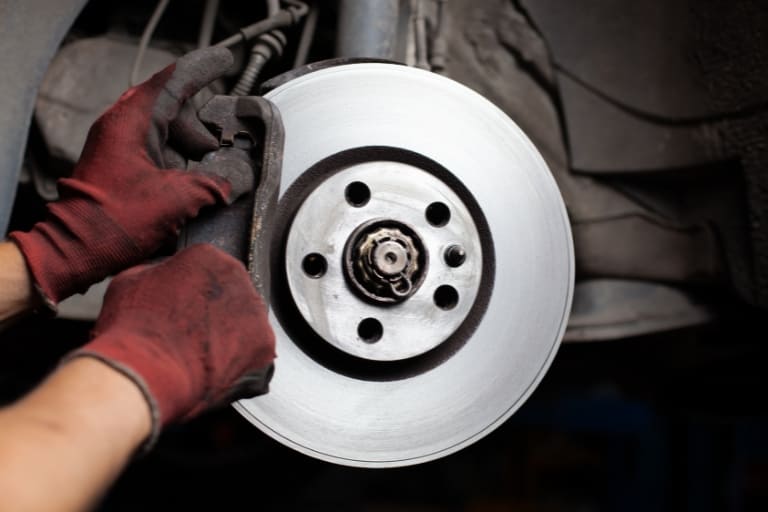
Swapping brake parts from other cars can be done, but it comes with risks and benefits. The main benefit is potential cost savings, as used or aftermarket parts from another vehicle may be cheaper than brand-new OEM parts.
However, compatibility is crucial, as brake parts are designed to fit specific makes, models, and years of vehicles. Using incompatible parts can affect braking performance and safety. Additionally, the condition and quality of used or aftermarket parts should be carefully assessed.
There’s also the risk of voiding warranties or guarantees. Swapping brake parts may be acceptable in some cases, such as using OEM parts from a similar make, model, and year. However, it’s best to consult a qualified mechanic or brake specialist for accurate assessment and to ensure safety and optimal braking performance.
Can I Change Brake Pads And Rotors Myself?
Yes. You can change brake pads and rotors with the necessary tools, knowledge, and experience. However, following proper procedures and safety precautions is important to ensure a successful installation. If you’re not confident in your abilities, it’s best to seek professional help to avoid any potential safety risks or damage to your vehicle.
Related Articles, You May Like:
- Brake Pads Not Touching the Whole Disc
- Why Wheel Won’t Spin After a Brake Change?
- Brake Shuddering After New Rotors and Pads
- Can You Use Front Brake Pads on The Rear?
- Why Does My Car Shake After Changing the Brake Pads?
- How to Install Anti-Rattle Clips on Brake Pads
- How Long Do Brake Pads Last: Brake Pad Lifespan Explained
- Driving Without Brake Pads: How Long is Safe?
- How Long Do Brake Pads Last: Brake Pad Lifespan Explained
- How to Fix New Ceramic Brake Pads Making Grinding Noise
- Ceramic vs. Semi-Metallic Brake Pads: Which is Better?
- Why Are My Brakes Grinding After New Pads And Rotors
- Ceramic vs OEM brake pads
- Ceramic vs Organic Brake Pads
- Ceramic vs Carbon Fiber Brake Pads
Conclusion
Finally, maintaining your car’s braking system is critical for safe driving. Brake pads and rotors are important in efficiently stopping your vehicle and protecting the safety of you, your passengers, and others on the road. Regular brake inspection, maintenance, and timely replacement are required to provide optimal braking performance and avoid potential accidents.
Compatibility, quality, and safety must be prioritized regarding interchangeable brake pads and selecting the correct brake parts. Brake component swapping should be done with prudence, considering the dangers and advantages and getting professional help if necessary. Using original equipment manufacturer (OEM) or respected aftermarket components that meet or exceed OEM requirements helps assure dependability and performance.
Prioritizing regular maintenance and utilizing the appropriate brake components can help ensure that your vehicle’s braking system performs well, giving you peace of mind on the road.
